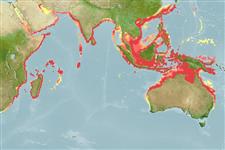Environment: milieu / climate zone / depth range / distribution range
Écologie
marin démersal; profondeur 7 - 200 m (Ref. 4417). Tropical; 30°N - 35°S, 24°E - 154°E
Indian Ocean: throughout the region including the Red Sea and Persian Gulf; south to Algoa Bay in South Africa (Ref. 4417). Western Pacific: Taiwan southward to New Guinea and extending to the northeastern coast of Australia.
Taille / Poids / Âge
Maturity: Lm ? range ? - ? cm
Max length : 37.5 cm TL mâle / non sexé; (Ref. 117081); common length : 15.0 cm SL mâle / non sexé; (Ref. 9774); poids max. publié: 760.00 g (Ref. 117081)
Épines dorsales (Total) : 0; Rayons mous dorsaux (Total) : 67 - 74; Épines anales: 0; Rayons mous anaux: 52 - 66. Eyed side with dark rings arranged in about 5 longitudinal rows; dark blotch at junction of straight and curved parts of lateral line and 2 smaller ones on the lateral line at posterior part of body and anterior end of caudal peduncle; small dark spots and elongate markings on median fins; pectoral fins with 10-12 rays on eyed side, 10-11 rays on blind side (Ref. 4417).
Found on clay, sand and mud bottoms of the continental shelf. Feeds on benthic animals (Ref. 5213). Mainly sold fresh.
Life cycle and mating behavior
Maturities | Reproduction | Spawnings | Egg(s) | Fecundities | Larves
Distinct pairing (Ref. 205).
Nielsen, J.G., 1984. Bothidae. In W. Fischer and G. Bianchi (eds.) FAO species identification sheets for fishery purposes. Western Indian Ocean fishing area 51. Vol. 1. FAO, Rome. pag. var. (Ref. 3322)
Statut dans la liste rouge de l'IUCN (Ref. 130435)
Menace pour l'homme
Harmless
Utilisations par l'homme
Pêcheries: commercial
Outils
Articles particuliers
Télécharger en XML
Sources Internet
Estimates based on models
Preferred temperature (Ref.
123201): 22.3 - 28.4, mean 26.9 °C (based on 1175 cells).
Phylogenetic diversity index (Ref.
82804): PD
50 = 0.5000 [Uniqueness, from 0.5 = low to 2.0 = high].
Bayesian length-weight: a=0.00692 (0.00537 - 0.00892), b=3.17 (3.12 - 3.22), in cm total length, based on LWR estimates for this species (Ref.
93245).
Niveau trophique (Ref.
69278): 3.5 ±0.37 se; based on food items.
Generation time: 1.1 ( na - na) years. Estimated as median ln(3)/K based on 1
growth studies.
Résilience (Ref.
120179): Haut, temps minimum de doublement de population inférieur à 15 mois (Preliminary K or Fecundity.).
Fishing Vulnerability (Ref.
59153): Low vulnerability (19 of 100).
